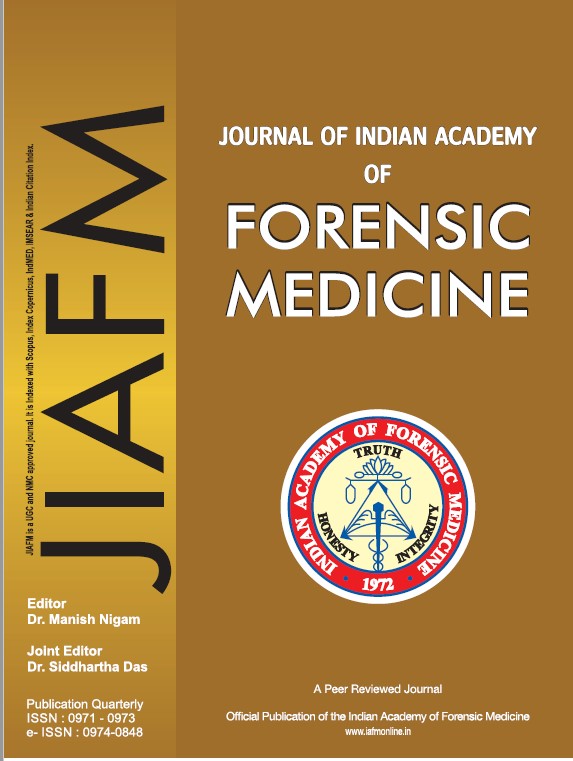Profile of Electrocution Deaths – A 3-Year Retrospective Study
DOI:
https://doi.org/10.48165/jiafm.2023.45.4.13Keywords:
Autopsy, Electrocution, Entry wounds, Exit wounds.Abstract
Electricity is no longer a privilege, instead a necessity. However, when 3.2% of the accidental deaths in 2021 are due to electrocution (n=12529), one must study the factors that result in such deaths so that the law enforcing and safety regulating agencies have a database to refer to while formulating laws. This is a retrospective study done in the Department of Forensic Medicine & Toxicology at Victoria hospital attached to Bangalore Medical College & Research Institute, Bengaluru. Data was collected using records from January 2018 to December 2022 during which 53 cases of deaths due to electrocution were autopsied. Using a proforma, information with respect to socio demographic factors, autopsy findings and cause of death was collected and analysed. On analysing the data collected, 0.6%, 0.7% and 0.7% (n= 14, 17, 22) of the total number of cases in 2020, 2021 and 2022 respectively were due to electrocution. A total of 53 cases were studied among which 45 were males (85%) and the rest were females. The highest number of cases (31%, n=17) were found in the 3rd decade of life. 40 cases (77%) were Hindus. Among the employed, 30.8% of them were electricians and 15.4% of them were construction workers. 27 cases had entry wounds at different sites on the upper limbs (19 in the right upper limb and 8 in the left upper limb). Visceral congestion, petechial haemorrhages in brain, lungs and heart were the common internal findings seen. Deaths due to electrocution need not present in a specific manner. Absence of entry wounds or exit wounds or both does not rule out electrocution. External examination and meticulous history taking is crucial to arrive at the cause of death.
Downloads
References
Modi JP, Kannan K. Atextbook of Medical jurisprudence and Toxicology. Injuries from burns, scalds, lightening & electricity. 27th ed. Gurgaon, Haryana, India: Lexisnexis; 2021: 643.
Crime in India 2021. National Crime Records Bureau. 2021.
Workplace Injury & Fatality Statistics. Electrical Safety Foundation International. [Cited 2021 February 20]. Available from: https://www.esfi.org/workplace safety/workplace-injury-fatality-statistics/;
Electrical hazards.[Cited 2021February 20]. Available from: https://www.osha.gov/harwoodgrants/grantmaterials /bytopic;
Shobhana SS. Raviraj KG. Pattern of electrocution deaths autopsied in South India – A 16 year retrospective study. Sri
Lanka Journal of Forensic Medicine, Science & Law. June 2022; 13 (1); 1-7.
Rao D. An autopsy study of fatal electrocution. IP International Journal of Forensic Medicine and Toxicological Sciences. 2022; 7(2): 56-9.
Kuhtic I. Bakovic M. Mayor D. Strinovic D. Petrovicki V. Electrical Mark in Electrocution Deaths : A 20-Years Study. The Open Forensic Science Journal. 2012; 5: 23-7.
Giri et al. Study of different facets of electrocution deaths: a 5- year review. Egyptian Journal of Forensic Sciences. 2019; 9:1-6.
Hardjanto P. Martin S. Nzilibili M. Yudianto A. Electrocution Death: Exit Mark Injury use in the Suggestion of Body Posture during Forensic Investigation. Proceedings of the 2nd International Conference Postgraduate School. 2018: 493-8.
Raymond M. Geddes LA. Conduction of Electrical Current to and Through the Human Body: AReview. Journal of Plastic Surgery. 2009; 9: 407-21.
and heart.


